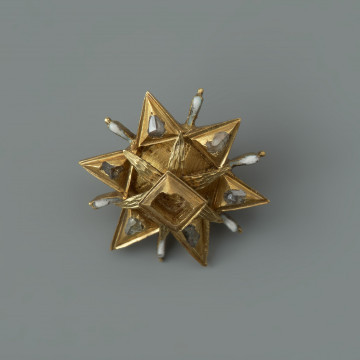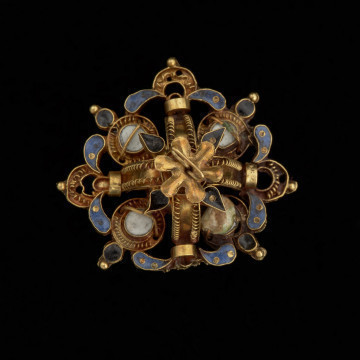
Star-shaped dress jewellery
nie po 1637
National Museum in Szczecin
Part of the collection: Jewels and costumes of Pomeranian dukes
One of the most fashionable accessories of men's clothing in the second and third decade of the 17th century were shoes with heels, cut-outs at the sides and a tongue. They were often decorated with bows or impressive lace rosettes. The shoe rosettes, part of the costume of the Pomeranian Duke Francis I, were made of lace with serrated edges. On their backs, fragments of narrow ribbons tied in a bow, with which they were fastened to the tops, have been preserved. The centre of the rosettes is decorated with tiny gold three-leaved jewels, called trinkets or dress jewels, with black enamel encrusted with gold stars and white enamel imitating pearls. How the lace rosettes looked together with Francis I's whole attire can be seen in the posthumous portrait of the Duke from 1621, preserved in the collections of the Cathedral Chapters of Merseburg and Naumburg and the Collegiate Church in Zeitz (currently on deposit at the exhibition The Golden Age of Pomerania in the National Museum in Szczecin). The ruler was dressed in tight-fitting doublet and fashionable knee-length heavily creased gold and black brocade fabric trousers. On his legs, he wore golden-yellow silk stockings and garters in the form of wide sashes of black silk tied in bows below his knees. The garters finished with lace threads with a gilt silver braid, harmonised with the golden lace rosettes at the yellow leather shoes.The identical lace rosettes with the characteristic three-leaved dress jewels in the middle can be seen on an unpreserved, but known from archive photography, the image of the Duke from 1616. As the Szczecin Dukes were buried in the clothes they wore during their lives, they are a valuable testimony to the culture of the House of Griffin, and more generally, to the culture of European courts of the time.
Monika Frankowska-Makała
Author / creator
Dimensions
cały obiekt:
Creation time / dating
Creation / finding place
Identification number
Location / status

nie po 1637
National Museum in Szczecin

nie po 1637
National Museum in Szczecin

około 1600
National Museum in Szczecin
DISCOVER this TOPIC
Museum of King Jan III's Palace at Wilanów
DISCOVER this PATH
Educational path